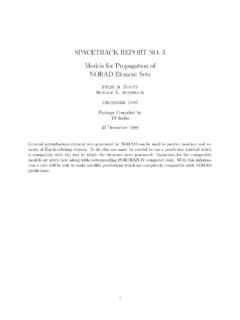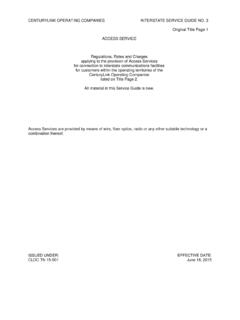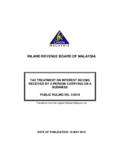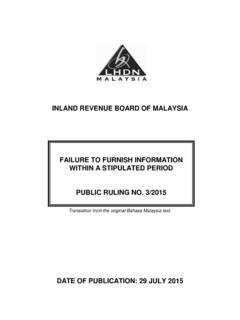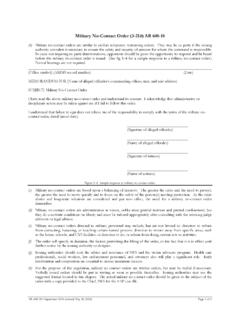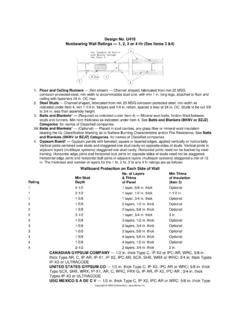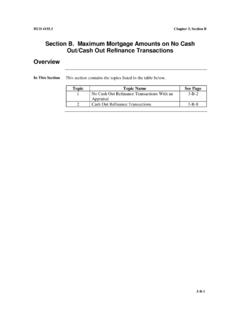Transcription of SSPC-SP 6/NACE NO. 3 - Allweld Mobile Sandblasting Ltd
1 SSPC-SP 6/NACE No. 3 September 1, 200060 Joint Surface Preparation StandardSSPC-SP 6/NACE NO. 3 Commercial Blast CleaningThis sspc : The Society for Protective Coatings andNACE International standard represents a consensus ofthose individual members who have reviewed this docu-ment, its scope and provisions. Its acceptance does not inany respect preclude anyone, having adopted the standardor not, from manufacturing, marketing, purchasing, or usingproducts, processes, or procedures not in conformancewith this standard. Nothing contained in this standard is tobe construed as granting any right, by implication or other-wise, to manufacture, sell, or use in connection with anymethod, apparatus, or product covered by Letters Patent, oras indemnifying or protecting anyone against liability forinfringement of Letters Patent.
2 This standard representsminimum requirements and should in no way be interpretedas a restriction on the use of better procedures or is this standard intended to apply in all casesrelating to the subject. Unpredictable circumstances maynegate the usefulness of this standard in specific and NACE assume no responsibility for the interpre-tation or use of this standard by other parties and acceptresponsibility for only those official interpretations issued bySSPC or NACE in accordance with their respective govern-ing procedures and policies, which preclude the issuance ofinterpretations by individual of this standard are responsible for reviewingappropriate health, safety, and regulatory documents andfor determining their applicability in relation to this standardprior to its use.
3 This sspc /NACE standard may not neces-sarily address all potential health and safety problems orenvironmental hazards associated with the use of materi-als, equipment and/or operations detailed or referred towithin this standard. Users of this standard are also respon-sible for establishing appropriate health, safety, and envi-ronmental protection practices, in consultation with appro-priate regulatory authorities, if necessary, to achieve com-pliance with any existing applicable regulatory require-ments prior to the use of this NOTICE: sspc /NACE standards aresubject to periodic review and may be revised or withdrawnat any time without prior notice.
4 sspc and NACE requirethat action be taken to reaffirm, revise, or withdraw thisstandard no later than five years from the date of initialpublication. The user is cautioned to obtain the latestedition. Purchasers may receive current information on allstandards and other publications by contacting the organi-zations at the addresses below: NACE Box 218340 Houston, TX 77218-8340(telephone +1 281/228-6200) sspc : The Society for Protective Coatings40 24th Street, Sixth FloorPittsburgh, PA 15222(telephone +1 412/281-2321)ForewordThis joint standard covers the use of blast cleaningabrasives to achieve a defined degree of cleaning of steelsurfaces prior to the application of a protective coating orlining system.
5 This standard is intended for use by coatingor lining specifiers, applicators, inspectors, or others whoseresponsibility it may be to define a standard degree ofsurface focus of this standard is commercial blast metal blast cleaning, near-white blast cleaning, indus-trial blast cleaning, and brush-off blast cleaning are ad-dressed in separate blast cleaning provides a greater degreeof cleaning than industrial blast cleaning ( SSPC-SP 14/NACE No. 8), but less than near-white blast cleaning ( SSPC-SP 10/NACE No. 2).Commercial blast cleaning is used when the objectiveis to remove all visible oil, grease, dust, dirt, mill scale, rust,coating, oxides, corrosion products and other foreign mat-ter, leaving staining or shadows on no more than 33 percentof each unit area of surface as described in Section difference between a commercial blast and a near-white blast is in the amount of staining permitted to remainon the surface.
6 Commercial blast allows stains or shadowson 33 percent of each unit area of surface. Near-white blastallows staining or shadows on only 5 percent of each difference between a commercial blast and anindustrial blast is that a commercial blast removes all visibleoil, grease, dust, dirt, mill scale, rust, coating, oxides, corro-sion products and other foreign matter from all surfaces andallows stains to remain on 33 percent of each unit area ofsurface, while industrial blast allows defined mill scale,coating, and rust to remain on less than 10 percent of thesurface and allows defined stains to remain on all 6/NACE No.
7 3 September 1, 200061 This joint standard was prepared by the sspc /NACETask Group A on Surface Preparation by Abrasive BlastCleaning. This joint Task Group includes members of boththe sspc Surface Preparation Committee and the NACEUnit Committee T-6G on Surface This joint standard covers the requirements forcommercial blast cleaning of unpainted or painted steelsurfaces by the use of abrasives. These requirementsinclude the end condition of the surface and materials andprocedures necessary to achieve and verify the end The mandatory requirements are described in Sec-tions 1 to 9 as follows:Section 1 GeneralSection 2 DefinitionSection 3 ReferencesSection 4 Procedures Before Blast CleaningSection 5 Blast Cleaning Methods and OperationSection 6 Blast Cleaning AbrasivesSection 7 Procedures Following Blast Cleaning andImmediately Prior to CoatingSection 8 InspectionSection 9 Safety and Environmental RequirementsNOTE.
8 Section 10, Comments and Appendix A, Explana-tory Notes are not mandatory requirements of this A commercial blast cleaned surface, when viewedwithout magnification, shall be free of all visible oil, grease,dust, dirt, mill scale, rust, coating, oxides, corrosion prod-ucts, and other foreign matter, except for staining as notedin Section Random staining shall be limited to no more than 33percent of each unit area of surface as defined in , and may consist of light shadows, slight streaks, orminor discolorations caused by stains of rust, stains of millscale, or stains of previously applied Acceptable variations in appearance that do notaffect surface cleanliness as defined in Section includevariations caused by type of steel, original surface condi-tion, thickness of the steel, weld metal, mill or fabricationmarks, heat treating, heat affected zones, blasting abra-sives, and differences due to blasting When a coating is specified, the surface shall beroughened to a degree suitable for the specified Immediately prior to coating application.
9 The entiresurface shall comply with the degree of cleaning Unit area for determinations shall be approximately5776 mm2 (9 in2) ( , a square 76 x 76 mm [3 in x 3 in]). sspc -VIS 1-89 may be specified to supplement thewritten definition. In any dispute, the written standards shalltake precedence over visual standards and information on visual standards and comparatorsis available in Section of Appendix The documents referenced in this standard arelisted in Section The latest issue, revision, or amendment of thereferenced standards in effect on the date of invitation to bidshall govern unless otherwise If there is a conflict between the requirements of anyof the cited reference standards and this standard, therequirements of this standard shall sspc : THE SOCIETY FOR PROTECTIVE COAT-INGS STANDARDS.
10 AB 1 Mineral and Slag AbrasivesAB 2 Cleanliness of Recycled Ferrous MetallicAbrasivesAB 3 Newly Manufactured or Re-ManufacturedSteel AbrasivesPA Guide 3A Guide to Safety in Paint ApplicationSP 1 Solvent CleaningVIS 1-89 Visual Standard for Abrasive BlastCleaned Steel4. Procedures Before Blast Before blast cleaning, visible deposits of oil, grease,or other contaminants shall be removed in accordance withSSPC-SP 1 or other agreed upon Before blast cleaning, surface imperfections suchas sharp fins, sharp edges, weld spatter, or burning slagshould be removed from the surface to the extent requiredby the procurement documents (project specification).
